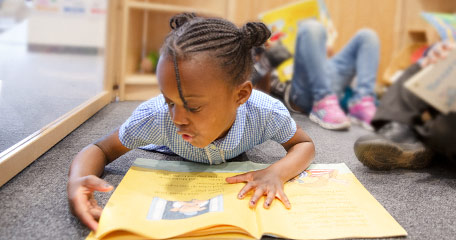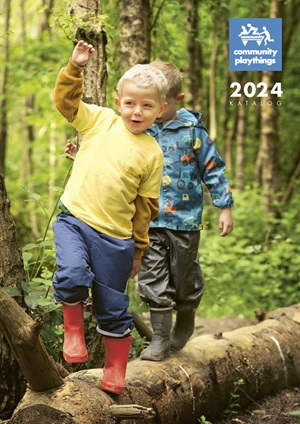Supporting language development
Building relationships in the early childhood classroom
| February 2017Helping children build vocabulary and develop language skills to get what they need and want is a key teaching task in the early childhood classroom. So many important developmental tasks are tied to children’s ability to access and use language in the right ways at the right time. And, one of the most important predictors of children’s future success as readers is the size of their vocabulary at age five.
Our impact as educators is particularly important for our most economically disadvantaged students. These children, studies show, may be exposed to as many as 3 million fewerwords by the age of three than their more advantaged peers. Further research has confirmed that language in general and vocabulary in particular is best developed in the context of relationships, in meaningful, reciprocal interactions about things that are important to the child. Mere exposure isn’t enough—your relationship with children is the foundation for language learning.
Children’s developing brains are wired to absorb language in early childhood. There are three types of language skills teachers should keep in mind.
Expressive Language:The words children use when they talk.
Receptive language:The words that children can understand, although they may or may not use them when they speak. Typically much more expansive than expressive language, especially for those who speak or are regularly exposed to a second language.
Pragmatic language:The way language is used in social settings—knowing what to say and how to say it to achieve a desired outcome. Requires a wide vocabulary, as well as a nuanced understanding of the social world.

The good news is that teachers can really make a difference in children’s language development. Infant and toddler teachers have a special role, as they recognise and respond to children’s earliest efforts to communicate, long before babies speak their first words. When the youngest children know that their voices are heard and valued, early foundational language development is supported.
Here are three ways you can help children develop the sophisticated language skills they need to succeed, in your classroom and in the wider world.
1. Use books to build vocabulary.
Ms. Kenzi is readingThe Pout-Pout Fish to her class of four-year-olds. They are in the middle of a whole unit on the ocean, and the children are very excited about the book. As she reads, “‘Mr. Fish is most astounded,’”she pauses and asks, “Astounded? Does anyone know what that means?” Brian says, “Surprised?” Nikki says, “Shocked?” Ms. Kenzi says, “You’re both right! Astounded is another word for feeling really surprised!”
This first strategy is so simple—you’re probably already doing it. In many classrooms, reading time plays a central role in the rhythm of our days. A slight shift in focus with this regular classroom feature is all it takes to target language development. Toddlers are rather notorious for their love of repetition—embrace this drive by reading the same book again and again (and encouraging families to do the same). This helps children begin to understand the rhythms of language and absorb the structure of sentences and storytelling. Alongside the regular favourites, introduce new books, taking advantage of current interests as you branch out.
Older preschoolers benefit from hearing and reading books with a wide variety of vocabulary and story-telling styles. When you come across a word children might not be familiar with, take a moment to talk about it. Ask children if they have an idea what it means—you might be surprised by what they know. Children often learn best from each other, so taking time to talk about what you read is an important vocabulary building exercise, and it helps you tune into their interests as you choose your next books.
Be sure that the books that you choose are well written, free from bias, and represent broad diversity of gender, race, abilities, family structures, and so on. Your local children’s librarian may be able to help, and there are a wealth of resources online for finding diverse, engaging, and high quality books. Read the books yourself first to be sure they are a good fit for you and your classroom. If you love a book, your enthusiasm will draw children in and connect them to all those new words.

2. Incorporate indirect language stimulation techniques.
Another mindful strategy that teachers can use is indirect language stimulation. Developed by speech and language pathologists, these techniques focus on the language you use as you interact with children, within the context of your relationship. They are excellent ways to help children develop more complex language skills and build larger vocabularies.
The first technique is description. To use this simple strategy, narrate or describe what is going on in the child’s world. When you notice an interest, explain to the child what he or she is seeing. This is especially useful with children under three, second language learners, and children with language delays who are working on building their expressive vocabulary.
“ Joseph is building a tall tower!”
“That’s Marissa’s stepmother. She’s here to pick Marissa up today.”
“There is broccoli, pasta, and strawberries on your plate.”
The second technique is parallel talk. Parallel talk is “you talk,” focusing on what the child is doing, connecting their actions to words in the form of a complete sentence, adding new vocabulary whenever possible. This also helps support your relationship, showing children you value them and are paying attention to what they are doing.
“You have a red shirt and plaid pants on today!”
“You are feeding your baby in the high chair.”
“You are digging a deep hole in the sand!”
Self-talkis the third language technique covered here. Self-talk focuses on your (the teacher’s) actions, explaining what you are doing and why—it is “I talk.” Self-talk is also good way to help children prepare for transitions, drawing their attention to the important cues you provide them about what will happen next. (Find out more about managing transitions.)
“ I am cleaning the table because it is almost time for snack.”
“I am packing up my bag because, in five minutes, it will be time to go inside.”
“I am writing a note to tell your dad that you rode a tricycle today all by yourself.”
One more indirect language stimulation technique is expansion. Expansion is an ideal strategy to use with children who are learning to put words together to express more complex ideas. This strategy takes what a child says and expands it—sometimes adding to it—to make a complete sentence, offer more nuanced vocabulary choices, and make the most of an opportunity to build connection with the child.
Max says, “Milk!” His teacher says, “You’d like some milk to drink! I’ll pour some for you.”
Leila says, “Mama bye-bye.” Her teacher says, “Your mum went to work. She’ll be back to pick you up after nap time.”
Amhed says, “Wow, big!” and his teacher says, “I see that truck, too! It’s enormous!!”
One key detail about indirect language stimulation techniques is that they require nothing of the child in that moment. Children are not required to repeat you or adjust their own language. Instead, they learn over time from your good example within the context of a warm and supportive relationship.

3. Support second language learning and be aware of children’s home culture.
Three-year-old Tavo is new to Mrs. Booker’s class. He has been at home with his mother until recently, where Spanish is the primary language spoken. Mrs. Booker greets him as he arrives, “Hola! ¿Cómo estás? Good morning! How are you?” She takes a moment to show his mother the new labels she made for the toy area, naming the contents of the bin in both Spanish and English. Before his mother leaves for the day, Mrs. Booker asks her to write down Tavo’s word for the special blanket he brought from home, so she’ll be able to offer it to him more easily, should he get upset and need it.
Currently, one in five residents of the United States speaks a language other than English at home, and many children enter childcare or early childhood classrooms as second language learners. While some educators and families worry that learning two languages at once might confuse a child, there is no evidence that this causes language delays. In fact, the benefits of being multilingual can last a lifetime.
When a child who is learning a new language enters your classroom, partner with his or her family. Ask family members to share key needs-meeting words, especially ones related to eating, sleeping, toileting, and pain. Then, focus on helping the child learn those new words right away, so they can communicate their basic needs, building the trust and sense of safety all children need in order to learn. Remember that learning a new language is both tiring and stressful—children may need extra support from you.
In your classroom, use pictures, labels, objects, and real events to link the language the child knows to the language he or she is learning. (This literacy and vocabulary-building strategy benefits every child.) Invite the child and his or her family to share their home language and culture in your classroom. Songs, books, and family holiday traditions are wonderful ways to connect all children with the wider world.
Finally, remember that culture and language are closely linked. It’s important to be aware that every culture has variations in the way it uses language. Nonverbal expectations like eye-contact, deference to adults, and what kinds of information are considered private, also vary.
The best way to learn about a family’s home culture and language is to ask. A questionnaire can be a useful, non-intrusive way to explore and expand your understanding. An Internet search can help you find blog posts and articles related to specific cultural nuances (but be sure you check your sources—the best resources are ones created by members of that particular group). Talking to colleagues and other adults from those cultural groups is also important—an objective third party can often tease out details that might get overlooked in everyday interactions.
Teachers play an important role in the language development of children in early childhood classrooms. Your efforts in building a relationship where communication is valued, and in implementing strategies that deliberately expand children’s vocabulary, make a lasting impact over their educational years.
References:
Colker, L. .2014. “The word gap: the early years make a difference.” Teaching Young Children,(7)3, 26-28 February/March. Retrieved from https://www.naeyc.org/tyc/article/the-word-gap/
Diesen, D. 2008. The Pout-Pout Fish. New York: Farrar, Straus, and Giroux.
Forrester, M. &K. Albrecht, 2014. Social Emotional Tools For Life: An early childhood teacher’s guide to supporting strong emotional foundations and successful social relationships.Houston: Innovations in ECE Press.
Gros-Louis, J., & M. West. 2014. “Maternal responsiveness and the development of directed vocalizing in social interactions.” Infancy¸ 19(4). 385-408, May 29. doi: 10.1111/infa.12054
Hart, B., & T.R. Risley. 2003. “The Early Catastrophe: The 30 million word gap by age 3.” American Educator. 27(1), 4-9.
Lowry, L. 2012. “Build your child’s vocabulary.” The Hanen Centre.Retrieved from https://www.hanen.org/helpful-info/articles/build-your-childs-vocabulary.aspx/
Nemeth, K. 2009. Many Languages, One Classroom: Teaching dual and English language learners.Washington DC: National Association for the Education of Young Children.
Nemeth, K. 2012. Basics of Supporting Dual Language Learners: An introduction for educators of children from birth through age 8.Washington DC: National Association for the Education of Young Children.
Rowe, M. 2012. “A longitudinal investigation of the role of quantity and quality of child-directed speech in vocabulary development.” Child Development, 85(5), 1762-1774. Retrieved from https://www.ncbi.nlm.nih.gov/pmc/articles/PMC3440540/
Zeigler, K., & S. Camarota. 2014. “One in five U.S. residents speaks foreign language at home, record 61.8 million.” Center for Immigration Studies. October. Retrieved from https://cis.org/record-one-in-five-us-residents-speaks-language-other-than-english-at-home/
Resources:
Children’s Book List from The Center on the Social and Emotional Foundations for Early Learning
9 Resources for Finding Multicultural Books for Children from the Institute for Humane Education






